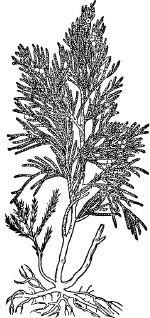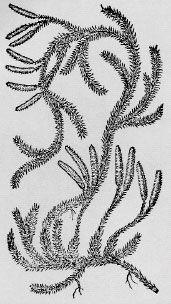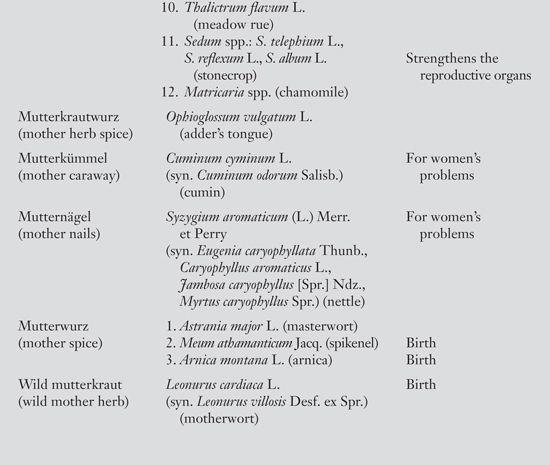Read Witchcraft Medicine: Healing Arts, Shamanic Practices, and Forbidden Plants Online
Authors: Claudia Müller-Ebeling,Christian Rätsch,Ph.D. Wolf-Dieter Storl
Witchcraft Medicine: Healing Arts, Shamanic Practices, and Forbidden Plants (39 page)

To whom does Heraclitus of Ephesus prophesize? The devotees of the night—the
magoi,
the bacchants, the maenads, the mystics. He threatens all of them with what comes after death, to all of them he prophesizes fire. For what the people consider pious mysteries are godless initiatory rites (
Protrepticus
22).
Unfortunately there are hardly any further sources that describe an initiatory mystery cult of Artemis. However, she was highly honored in the Orphic Dionysian rites. During the Orphic rites storax was brought to her as an incense offering.

A witch roams through the woods. At her feet is fly agaric. The association of fly agaric with witchcraft was developed only in recent times. (
The Witch
by Heinrich Vogeler, pen-and-ink drawing, c. 1900.)
The garden of Artemis was the wild nature. It was there that the shaman-goddess liked to spend her time. It was where she found her medicinal plants and her magical herbs: “There are three types of Artemisia. All three and their healing effects were discovered by the goddess Diana. She transmitted this medicine chest to the centaur Chiron, who was the first to transform it into medicine. This is why these plants carry the name of Diana, or rather Artemisia” (
Medicina antiqua
13, fol. 32r).
Mugwort (
Artemisia vulgaris
L.) stands in the primary position. It is a sacred plant of the goddess. In earlier times it was called
Artemisia monoclonos
and was an important medicine.
When people carry the plant artemisia, they don’t feel the difficulty of the path. Kept in the house, it chases away demons, protects from bad medicine, and averts the evil eye. Grinding the artemisia in lard and rubbing it on the feet relieves aches. The grounded and pulverized artemisia is administered with water and mead as a drink; it takes away the intestinal pain and helps in various conditions of weakness (
Medicina antiqua
11, fol. 30r).
Tarragon (
Artemisia dracunculus
L.) was called
Artemisia tagantes
and was used not only as a seasoning, but also in many ways as a medicinal plant.
For bladder pain and strangles. For those without a fever, give 2 scruples artemisia juice in a glass of wine to drink; those with one use two glasses of hot water. For hip pain: grind the plant
Artemisia tagantes
and mix it with lard and vinegar; on the third day [the pains] will be healed without complications. For nerve pain: the ground plant
Artemisia tagantes
works good with oil and rubbed on the skin; it heals wonderfully. … Light the artemisia and let the smoke go over the child, this will avert all dangers and makes the child happy (
Medicina antiqua
12, fol. 31r).
Roman artemisia (
Artemisia pontica
L.) was used mainly for nerve pain.
The
Artemisia leptafillos
is ground and worked into a kind of salve with almond oil. Then it is smeared on a clean piece of linen [a bandage is made]; on the fifth day the healing will be complete. When the roots of the artemisia are hung over the threshold of a building no one in the house will be harmed. Make a rub from the juice of
Artemisia leptafillos
and rose oil; it soothes the pain and the trembling and dispels all problems (
Medicina antiqua
13, fol. 32r).

Because it is poisonous, savine (
Juniperus sabina
L.) is considered a tree of the dead; it was used in folk medicine mainly as an abortifacient. For this reason the plant was connected to witches. Hieronymus Bock wrote in his herbal, “Of it the old witches and whores pay attention to the first sprout / so that the priest or others of stinking Juniper throw palms on the cross / given to the same sprout are said to be good for the hawen and choking / for witchery / evil ghosts / and make with it many adventures / allowing from new offerings / and read masses over it. Finally they lead the young whores / give them seuen-palms powdered / or drink over it / thereby many children will be ruined. Such practices require a sharp Inquisitor and master.” The tips of the branches are an important incense of the Mongolian shaman. (Woodcut from Hieronymus Bock,
Kreütterbuch,
1577.)
The Divine Herbs of Midwifery
Artemis is the guardian goddess of birth and abortion and the guardian of midwives. Mugwort, which is sacred to her, is considered a gynecological panacea. But to the flora of Artemis belong many further
Mutterkräuter
(mother herbs)—herbs for the mother and the womb. Therefore it is evident that all of these plants were demonized and associated in the vernacular with the plants of witches and devils. (See the appendix and the box on page 125.)
Poleo mint (
Mentha pulegium
L.) also bloomed in the garden of Artemis. It was used in antiquity as a potent abortifacient and a favorite incense. The witch persecutor Bodin (1591) identified the aromatic herb as the Homeric
nepenthes
(“soothing plant”) and demonized it as a witches’ herb (Beckmann and Beckmann, 1990: 201).
Savine (
Juniperus sabina
L.) also came under the protection of Artemis. Its common names included “child murder” and “virgin palm.” Since antiquity it has been considered one of the most powerful and effective natural abortifacients. However, the use of the branch tips or the top shoots of savine for abortion is not entirely without danger. A decoction of fifty to sixty grams of the tips causes a strong rush of blood in the abdomen, urinary tract infections, and abortions and can also lead to fatal poisoning (Leibrock-Plehn, 1992 and 1993: 81). Nevertheless, most lethal poisoning comes from improper use by the layman. Savine has been one of the most famous abortifacients even into our era, and was demonized by the Church and by the state: “Planting it in public gardens was forbidden in some instances, because the top shoots were regularly discovered to have been harvested” (Leibrock-Plehn, 1993: 81).
Other Artemis herbs of antiquity were used in a very similar ways. The ancient Greeks called the true dittany (
Origanum dictanmus
L.)
102
Artemidion
or
Artemidioncre,
which means “Artemis plant.”
Diktamnos, which some called wild poleo, others call it
embaktron
,
beluakos
[medicine against arrows],
artemidion
[Artemis plant], the Cretes
ephemeron, eldia, belotokos
[arrow quick birth maker],
dorkidion
[fawn],
elbunuin
, the Romans
ustilago rustica
[coltsfoot]. … It has the same effect as the cultivated poleo, only much more potent; for not only drunken, but also in suppositories and in incense it expels the dead fetus. … Eating the root is warming and speeds the birth along (Dioscorides,
Materia medica
III.34).
Dittany also was known as
Labrum Veneris,
which means “Venus lips.” The name
artemisiod
was a reference to the hunter Artemis, who could wound as well as heal wounds with her poisonous arrows.
The juice of the ground and pressed dittany plant, administered as a drink, heals extraordinarily effectively [for poisoning]. But the effects of dittany are so great that it kills all snakes by its presence alone—no matter where they are. When its scent is carried further by the wind it kills snakes promptly. As a proof it was added that wild goats or stags, when they are wounded by the [poisoned] shot of a hunter, seek out the plant diptamnum and eat it; thus the animal is able to shake the arrow out and heal the wound while it is eating the plant (
Medicina antiqua
63, fol. 69v).
The doctor and preacher Otto Brunfels (1498–1534) wrote that dittany was used in a drink or a vaginal suppository for abortion, and the incense also worked as an abortifacient.
103
The entire plant has a volatile oil that contains carvacrol, pinin, cedrol, p-Cymol, and other phenols, as well as bitter properties and tannic acid.
The dittany of Crete is still recommended as a panacea and aphrodisiac: “It is considered a panacea and is often used for colds, stomach and intestinal complaints, for diseases of spleen, for rheumatism, and for delivery. Dittany is a calming tea and a wound medicine” (Iatridis, 1986: 92).
The “Green Fairy”: Wormwood and Absinthe
One of the best medicinal plants from the garden of Artemis must certainly be wormwood (
Artemisia absinthium
L.). Ancient literature is full of praise for this herb.
Grind the plant absintium and administer the pressed juice to drink; after mushroom poisoning such a person will go on to live to be one hundred years old. The plant absintium is cooked in water and placed on linen and a bandage made from it, this clears bruises. For sensitive skin rub it on with honey. Grind equal amounts of the plants absintium, marrubium, and lupinum and cook in honey water or spiced wine and stroke it on the navel to kill worms. Take a stalk of the plant absintium and girdle yourself with it, its healing powers are astonishing (
Medicina antiqua
102, fol. 1003/100v).

Common club moss (
Lycopodium clavatum
L.) is one of the most important magic plants in European history, as can easily be seen in its common names: druid foot, druid grass, witches’ herb, witches’ moss, witches’ dance, devil’s band, devil’s flower, wolf’s claw. In the Middle Ages club moss was used in gynecology. Into the twentieth century the spores of the club moss were offered in pharmacies as “witches’ grain,” used mainly as a wound powder. Today club moss still has a multifaceted use in homeopathy (Lycopodium hom.), particularly in diseases of the genitourinary tract. In Peru many different species of club moss become psychoactive when used in connection with the San Pedro cactus (
Trichocereus pachanoi
A. Berger)
.
(Woodcut from Gerard,
The Herbal,
1633.)
The “Mother Herbs” in Witchcraft Medicine
Following Aigremont, 1987; Beckmann and Beckmann, 1990; Leibrock-Plehn, 1992 and 1993; expanded by Rätsch.




